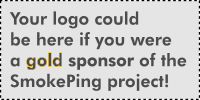Smokeping::probes::EchoPingHttp
Measures HTTP roundtrip times (web servers and caches) for SmokePing.
*** Probes ***
+EchoPingHttp
binary = /usr/bin/echoping
forks = 5
offset = 50%
step = 300
# The following variables can be overridden in each target section
extraopts = -some-letter-the-author-did-not-think-of
ignore_cache = yes
ipversion = 4
pings = 5
port = 80
priority = 6
revalidate_data = no
timeout = 1
tos = 0xa0
url = /
waittime = 1
# [...]
*** Targets ***
probe = EchoPingHttp # if this should be the default probe
# [...]
+ mytarget
# probe = EchoPingHttp # if the default probe is something else
host = my.host
extraopts = -some-letter-the-author-did-not-think-of
ignore_cache = yes
ipversion = 4
pings = 5
port = 80
priority = 6
revalidate_data = no
timeout = 1
tos = 0xa0
url = /
waittime = 1
Supported probe-specific variables:
- binary
-
The location of your echoping binary.
-
Default value: /usr/bin/echoping
- forks
-
Run this many concurrent processes at maximum
-
Example value: 5
-
Default value: 5
- offset
-
If you run many probes concurrently you may want to prevent them from
hitting your network all at the same time. Using the probe-specific
offset parameter you can change the point in time when each probe will
be run. Offset is specified in % of total interval, or alternatively as
'random', and the offset from the 'General' section is used if nothing
is specified here. Note that this does NOT influence the rrds itself,
it is just a matter of when data acqusition is initiated.
(This variable is only applicable if the variable 'concurrentprobes' is set
in the 'General' section.)
-
Example value: 50%
- step
-
Duration of the base interval that this probe should use, if different
from the one specified in the 'Database' section. Note that the step in
the RRD files is fixed when they are originally generated, and if you
change the step parameter afterwards, you'll have to delete the old RRD
files or somehow convert them. (This variable is only applicable if
the variable 'concurrentprobes' is set in the 'General' section.)
-
Example value: 300
Supported target-specific variables:
- extraopts
-
Any extra options specified here will be passed unmodified to echoping(1).
-
Example value: -some-letter-the-author-did-not-think-of
- ignore_cache
-
The
echoping(1) ``-A'' option: force the proxy to ignore the cache.
Enabled if the value is anything other than 'no' or '0'.
-
Example value: yes
- ipversion
-
The IP protocol used. Possible values are ``4'' and ``6''.
Passed to
echoping(1) as the ``-4'' or ``-6'' options.
-
Example value: 4
- pings
-
How many pings should be sent to each target, if different from the global
value specified in the Database section. Note that the number of pings in
the RRD files is fixed when they are originally generated, and if you
change this parameter afterwards, you'll have to delete the old RRD
files or somehow convert them.
-
Example value: 5
- port
-
The TCP port to use.
-
Example value: 80
- priority
-
The ``-p''
echoping(1) option.
-
Example value: 6
- revalidate_data
-
The
echoping(1) ``-a'' option: force the proxy to revalidate data with original
server. Enabled if the value is anything other than 'no' or '0'.
-
Example value: no
- timeout
-
The ``-t''
echoping(1) option.
-
Example value: 1
-
Default value: 5
- tos
-
The ``-P''
echoping(1) option.
-
Example value: 0xa0
- url
-
The URL to be requested from the web server or cache. Can be either relative
(/...) for web servers or absolute (http://...) for caches.
-
Default value: /
- waittime
-
The ``-w''
echoping(1) option.
-
Example value: 1
Niko Tyni <ntyni@iki.fi>
You should consider setting a lower value for the pings variable than the
default 20, as repetitive URL fetching may be quite heavy on the server.
The fill, size and udp EchoPing variables are not valid for EchoPingHttp.
the Smokeping::probes::EchoPing manpage, the Smokeping::probes::EchoPingHttps manpage

